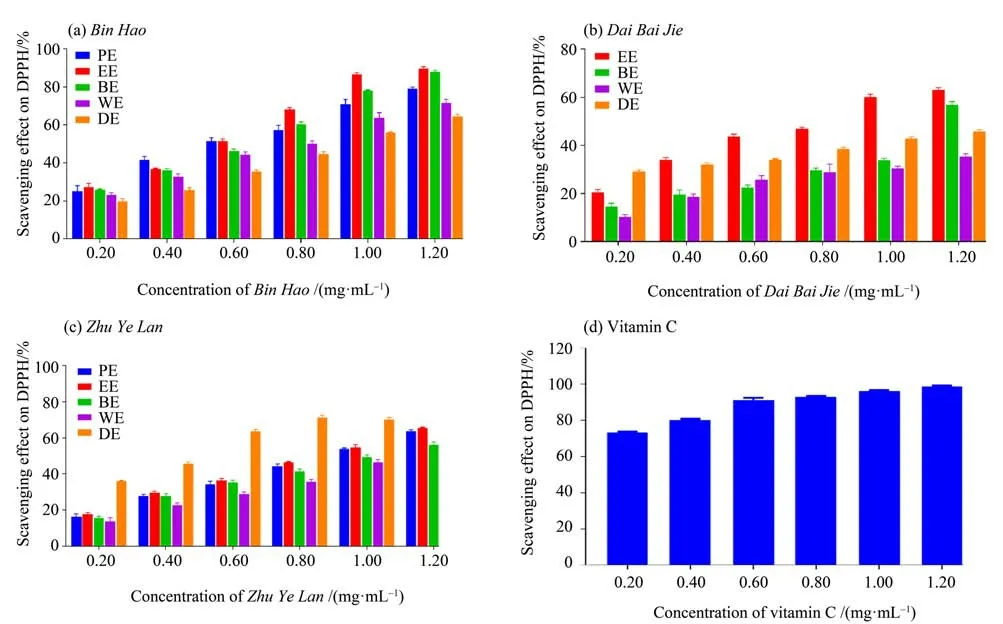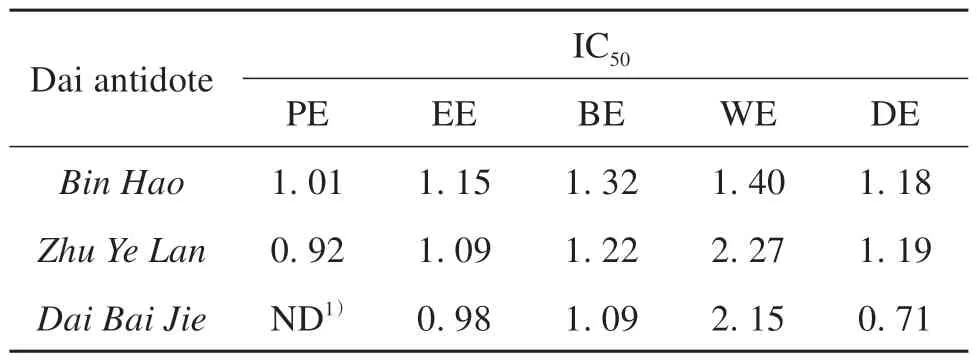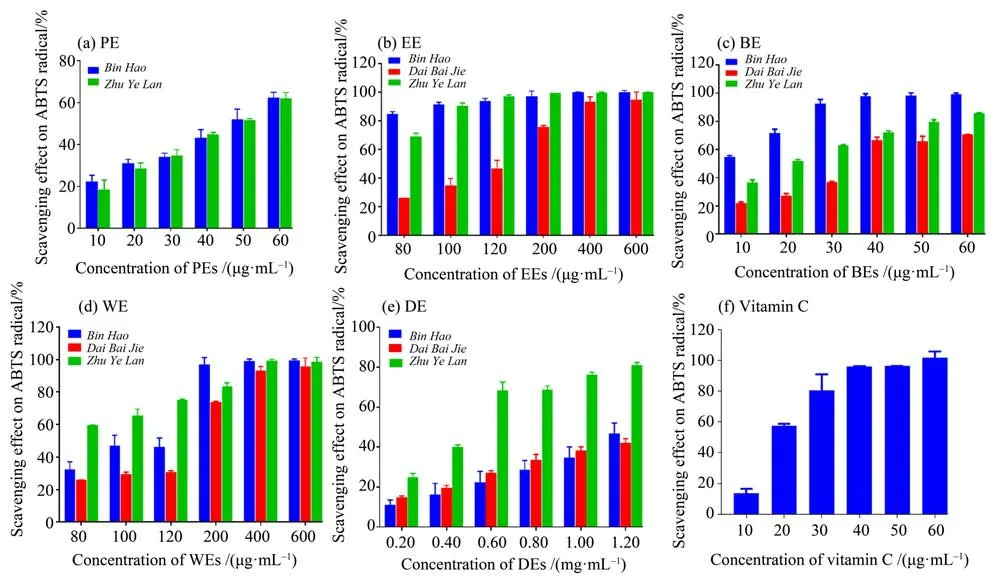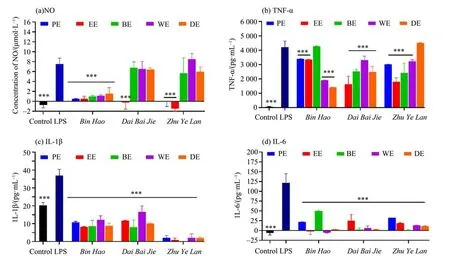Biological activities and detoxification mechanisms of Clerodendrum chinense var. simplex, Marsdenia tenacissima and Arundina graminifolia: The Dai antidotes*
,,,,,,,
1. School of Traditional Dai-Thai Medicine, West Yunnan University of Applied Sciences,Jinghong 666100, China
2. School of Pharmaceutical Sciences, Sun Yat-sen University, Guangzhou 510006, China
3. Yunnan Dai Medicine Co., Ltd., Ruili 678699, China
Abstract: Dai antidotes are the most distinctive medicine and treatment in traditional Dai medicine.Bin Hao (Clerodendrum chinense var.simplex), Dai Bai Jie (Marsdenia tenacissima) and Zhu Ye Lan (Arun‐dina graminifolia) are three Dai antidotes widely used for their "detoxifying effects", and their use is rooted in a theoretical system significantly different and much less understood than Western or tradi‐tional Chinese medicines.Here, we successively extracted the three Dai antidotes using petroleum ether, ethyl acetate, n-butanol, or water, and then prepared their decoctions.The content of total flavo‐noids in three Dai antidotes ranged from 22.41 to 586.39 mg/g, which is higher than the content of total polyphenols (2.76 to 28.66 mg/g).The various extracts were found to scavenge radicals of DPPH, ·OH and ABTS.They scavenged ABTS radicals much more efficiently than other radicals (IC50 > 380 μg/mL).They weakly inhibited the growth of E. coli, P. aeruginosa and S. aureus. Notably, even at low concentra‐tion 60 μg/mL, the extracts can significantly down-regulate the production of NO, TNF-α, IL-1β, and IL-6 by macrophages stimulated with LPS.In conclusion, our results provide the first mechanistic insights into the detoxifying effects of three Dai antidotes, providing a foundation for their optimization and for future research to strengthen Dai medicine through modern scientific practices.
Key words: Dai antidote; Clerodendrum chinense var. simplex; Marsdenia tenacissima; Arundina graminifolia; detoxification
As one of the four major ethnomedicines in China (Wang et al., 2017 ), Dai medicine dates back more than 2 500 years (Li et al., 2019) and continues to play an important role in health care in China and many other countries of southeast Asia, especially in the Mekong River valley."Yajie", is also known as Dai antidotes, refers to the medicine that can regulate the function of four cosmic elements in the body and is widely used among Dai medical practitioners to de‐toxify body toxins obtained from food, drug or animal bites, etc.It is the most distinctive medicine and treat‐ment method in Dai medicine.(Zhang et al., 2012).Bin Hao(Clerodendrum chinensevar.simplex),Dai Bai Jie(Marsdenia tenacissima)andZhu Ye Lan(Arundina graminifolia)(Fig.1), are widely used Dai antidotes.Mainly,Bin Haois used to treat cough,sore throat, rheumatic arthralgia and jaundice (Li et al.,2018),Dai Bai Jie, to treat cough, swelling and throat pain(Li et al.,2014), andZhu Ye Lan, to treat all kinds of poisoning caused by food and medicine,abdominal pain, diarrhea, dizziness and other diseases(Qu et al., 2011).

Fig.1 Schematic representation of research contents of Bin Hao, Dai Bai Jie and Zhu Ye Lan
There are few studies, using modern biomedical techniques to analyze the clinical benefits of Dai anti‐dotes limiting the use of Dai medicine.In fact, the Dai theoretical system remains completely outside from modern medical science and research.Com‐pared with other types of traditional Chinese medi‐cine, which already have a large number of literatures and clinical practice integrated with western medi‐cine, we are unaware the overlap and complementarity between the Dai theoretical system and traditional Chinese medicine or western medicine.
Dai medical theory holds that disease is related to imbalance among the four cosmic elements in the body, and that such imbalance can arise due to the presence of toxins (Zhang et al.,2012).This im‐balance may be attributed to imbalance between free radicals and anti-oxidant defenses ( Oszmianski et al., 2020) or imbalance between pro- and antiinflammatory factors, such as in excessive inflamma‐tion or infection with pathogens.All these im‐balances can lead to a disease initiation and progres‐sion.Therefore, the present study used standard and well-established laboratory methods to assess thein vitroantioxidant, anti-bacterial and anti-inflammatory effects of the three Dai antidotes.In addition, the ma‐terial basis of three Dai antidotes were explored by de‐termining their contents of total polyphenols and fla‐vonoids, as described in Fig.1.The results may help explain the clinical efficacy of these traditional medi‐cines, providing a modern scientific foundation for un‐derstanding and developing Dai medicine for the treat‐ment of various diseases as well as expanding their use in other regions of the world.
1 Methods
1.1 Plant material, reagents and cells
TheBin Hao,Dai Bai JieandZhu Ye Lanwere purchased from the Institute of Ethnic Medicine(Xishuangbanna, Yunnan Province) and identified by Mrs.Lin Yanfang, chief expert of Dai Medicine.They were washed and dried for two weeks in the shade.Before extraction, the plants were cut into small pieces and crushed using a floor-standing con‐tinuous feed grinder (DF-35, Wenling Linda Machinery,Zhejiang, China).
DPPH, ABTS, hydrogen peroxide (H2O2), rutin,gallic acid and potassium persulfate were purchased from Aladdin (Shanghai, China); Vitamin C was ob‐tained from Solarbio Science & Technology Co.,Ltd.(Beijing, China).Ethylparaben was purchased from Sigma-Aldrich (USA).Luria-Bertani (LB)broth was purchased from Hopebio (Qingdao, China);E.coli(ATCC 25922),P.aeruginosa(ATCC 27853), andS.aureus(ATCC 25923), were obtained from Huankai Guangzhou Microbial.RAW 264.7 macrophage cells were purchased from the Labora‐tory Animal Center of Sun Yat-sen University (Guang‐zhou, China).
Dulbecco's Modified Eagle Medium (DMEM)and fetal bovine serum (FBS) were obtained from Gibco-Thermo Fisher Scientific (Grand Island, NY,USA).LPS was purchased from Sigma Chemical(St.Louis, USA).NO Griess reagent was acquired from Beyotime Institute of Biotechnology (Shanghai,China).IL-1β, IL-6 and TNF-α ELISA kits were pur‐chased from Boster Biological Technology (Wuhan,China).All other reagents were purchased as analyti‐cal reagent grade and used without further purifica‐tion.
1.2 Extraction of Dai antidotes
CrushedBin Hao,Zhu Ye LanandDai Bai Jiewere extracted three times with 95% ethanol at a mass-to-volume ratio of 1:10 for 2 h at 98 ℃.The ex‐tracts were filtered, combined, and evaporated under reduced pressure to obtain crude ethanol extract.The polar extracts were obtained from the corresponding crude extract by successive extraction with the same volume of solvents of increasing polarity: petroleum ether, ethyl acetate,n-butanol and distilled water.Then, we obtained the petroleum ether extract (PE),ethyl acetate extract (EE),n-butanol extract (BE) and water extract (WE), respectively.
Aqueous decoctions (DE) of the three Dai anti‐dotes were prepared by mixing 100 g driedBin Hao,Zhu Ye LanorDai Bai Jiewith 1 000 mL of distilled water and boiling for 0.5 h and repeat three times.The decoctions were filtered with gauze, combined and concentrated to 50 mL, giving crude Dai anti‐dotes 2 g/mL.
1.3 Determination of total flavonoids content
The total flavonoids content of the samples was determined as described by Hossain et al.(2011).Briefly, 200 μL of samples, 200 μL of ethanol and 40 μL ofw=10% NaNO2was mixed and allowed to stand for 7 min.Then, 40 μL ofw=5% Al(NO3)3solu‐tion was added.After 7 min, 400 μL of 1 mol/L NaOH and 120 μL ethanol was added to the solution.The absorbance of obtained mixture was measured at 510 nm.In the same way, the standard solution was prepared with rutin in a series of concentration gradi‐ents, and the standard curve was drawn to calculate the flavonoids content.The total flavonoids content of different extracts was expressed as mg of rutin equivalents per g of dry weight of plant material(mg/g).
The linear equation was
and the correlation coefficientR2= 0.996.
1.4 Determination of total polyphenols content
The total polyphenols content of Dai antidotes was determined by using Folin-Ciocalteu reagent as described by Hossain et al.(2014).Briefly, 0.2 mL of samples, 6 mL of ethanol and 0.5 mL of Folin reagent were mixed to the 10 mL volumetric flask.After 5 min, 1.5 mL of 20% (w) Na₂CO₃ was added,dilute with water to volume and incubated at room temperature for 60 min, then absorbance was mea‐sured at 765 nm.In the same way, the standard solu‐tion was prepared with gallic acid in a series of con‐centration gradients, and the standard curve was drawn to calculate the polyphenols content, the total polyphenols content of different extracts was expressed as mg of gallic acid equivalents per g of dry weight of plant material (mg/g).
The linear equation was
and the correlation coefficientR2= 0.999 5.
1.5 In vitro anti-oxidant activity
Thein vitroanti-oxidant activities of different polar extracts and decoctions of the three Dai anti‐dotes were evaluated based on ability to scavenge DPPH free radicals, ·OH radicals and ABTS radicals,and vitamin C was used as positive control.Absor‐bance was determined on an ultraviolet spectropho‐tometer (UV-2600, Techcomp, Shanghai, China).
The scavenging effects on DPPH free radical was determined by the method as described by Dong et al (2017) with modifications, 3.0 mL of DPPH(0.1 mmol/L)was intermingled with 1 mL of each sample and allowed to stand at 37 ℃ for 30 min.The absor‐bance was then measured at 517 nm.
The scavenging effects on ·OH was determined based on Fenton's reaction as described by Aquino-Martins et al(de Queiroz et al., 2019) with modifica‐tions.1 mL of samples with different concentrations was mixed with 1 mL 9 mmol/L FeSO4solution, 9 mmol/L salicylic acid ethanol solution, and 8.8 mmol/L H2O2solution, respectively, and incubated at 37 ℃ for 30 min, then absorbance was measured at 510 nm.
The protocol of scavenging effects on ABTS free radical was adapted from Re et al.(1999), ABTS reagent (7.0 mmol/L) was mixed with 2.45 mmol/L potassium persulfate in a volume ratio of 1:1, and al‐lowing the mixture to stand in the dark at room tem‐perature overnight to obtain an ABTS stock solution.Then the ABTS stock solution was diluted with deionized water to obtain ABTS working solution with an absorbance value of 0.70 ± 0.05 at 734 nm.4.0 mL of ABTS working solution was intermingled with 1 mL of each sample, and incubated at 37 ℃ in dark for 30 min.The absorbance was then measured at 734 nm.
The scavenging DPPH, ·OH and ABTS freeradical effect according to the following equations
whereA0is the absorbance of the control,A1is the ab‐sorbance of the samples,A2is the absorbance of the sample background.
1.6 In vitro anti-bacterial activity
The anti-bacterial activity of three Dai antidotes were evaluated by determining the MICs, MBCs and ZOI againstE.coli,P.aeruginosaandS.aureus,and ethylparaben was used as positive control.
The MICs was determined by microtiter broth di‐lution method.In brief, 100 μL of bacteria suspen‐sion with the dilution of 1∶10 was inoculated in the 96-well plates, the extracts were diluted serially, then 100 μL of the diluted extracts solutions were added subsequently.The inoculated microplates were incu‐bated under microaerobic conditions at 37 ℃ for 24 h with shaking (100 r/min).The lowest concentration resulting in no visible growth of tested organisms was recognized as MICs.
For determination of MBCs, 10 µL of the bacte‐rial suspension and sample (which shown no visible growth) inoculated onto the appropriated agar and in‐cubated at 37 ℃ for 24 h.The lowest concentration that completely prevented microbial growth in LB broth agar was recognized as MBCs.
To assess ZOI in an agar diffusion model, 50 μL of bacterial lawns were prepared on a nutrient agar plate using the spread plate method.After soaking the sterile double-layer circular filter paper (diameter 6 mm) in each sample solution for 2 h, the filter paper was removed, dried, and gently put it on the corre‐sponding position of the plate.Then, these petri dishes were incubated at 37 ℃ for 24 h.Negative controls were DMSO and H2O.Then, the ZOI diameter was measured by digital calipers, and was recorded in cm.
1.7 In vitro anti-inflammatory activity
1.7.1 CellcultureThe RAW 264.7 cells were cultured in DMEM supplemented withφ=10% FBS and antibiotics (streptomycin 100 U/mL and penicillin 100 U/mL) in a humidified atmosphere ofφ=5% CO2at 37 °C.
1.7.2 Determinationof NO,IL-1β,IL-6,TNF-α productionAccording to the literature (Yan et al.,2021), RAW 264.7 cells, were seeded in 96 well plates at a density of 1 × 104cells/mL and incubated for 24 h.Then, the cells were incubated with respec‐tive extracts of three Dai antidotes and exposed to LPS (1 μg/mL) for 24 h.The blank control cells were treated with DMEM only.LPS-induced NO pro‐duction was determined by using Griess reagent, and the absorbance at 540 nm was measured using a micro‐plate reader (Molecular Devices, Flex Station 3).The generation of IL-1β,IL-6, TNF-α was determined by using ELISA Kit, and the absorbance at 450 nm was measured.
1.8 Statistical analysis
Statistical analysis were performed using SPSS Statistics for Windows, software version 25.0 (SPSS Inc., Chicago, IL, USA).A one-way analysis of vari‐ance (ANOVA) and the least significant difference test were employed to analyze the data.
2 Results
2.1 The contents of total flavonoids and polyphe‐nols
As shown in Fig.2, the contents of total flavo‐noids in three Dai antidotes (22.41 to 586.40 mg/g)were much higher than that of total polyphenols(2.76 to 28.66 mg/g), andZhu Ye Lanwas higher thanBin HaoandDai Bai Jie.In general, with the increase polarity of solvents, the total polyphenols and flavonoids content decreased and the contents in decoctions was higher than that of water extracts.

Fig.2 Contents of total flavonoids and polyphenols in three Dai antidotes
2.2 Antioxidant activity
2.2.1 Abilityto scavenge DPPH radicalsAll extracts showed dose-dependent DPPH scavenging activity (Fig.3).In the case ofBin Hao, as the con‐centration increases, extracts with lower polarity showed greater scavenging activity than that higher polarity.While, the DE showed the weakest scavenging at every tested concentration (Fig.3a).

Fig.3 Ability of various extracts of the Dai antidotes to scavenge DPPH radicals
In the case ofDai Bai Jie, more polar extracts showed less scavenging activity (Fig.3b).The DE showed greater scavenging ability than WE, but less than that of EE or BE.
In case ofZhu Ye Lan, more polar extracts also showed less scavenging activity (Fig.3c).The DE showed greater scavenging activity than any of the polar extracts.
Furthermore, the activity was quantified in terms of the half-maximal inhibitory concentration (IC50),the results showed that the scavenging DPPH radicals'ability ofBin Haoalcohol extracts was better than that of the other two Dai antidotes (Table 1).How‐ever, the scavenging DPPH radicals' ability ofZhu Ye Landecoction was better than that ofBin HaoorDaiBai Jie.The scavenging DPPH radicals' activity of three Dai antidotes were weaker than vitamin C (IC500.09 mg/mL).

Table 1 Quantitation of DPPH radical scavenging activity by three Dai antidotes mg/mL
2.2.2 Abilityto scavenge ·OH radicalsExtracts from the three Dai antidotes showed a weak, dose-de‐pendent scavenging activity of ·OH radicals (Fig.4).In case ofBin Hao, polar extracts and decoctionshowed similar scavenging activity (Fig.4a).In the case ofDai Bai Jie, as the polarity increased, the scav‐enging activity of extracts was decreased (Fig.4b).The scavenging activities of DE and EE were similar.Similarly, in the case ofZhu Ye Lan, greater polarity was associated with weaker scavenging (Fig.4c), and the scavenging activities of DE were also like EE.

Fig.4 Ability of Dai antidotes to scavenge ·OH
Comparison of IC50values showed that polar ex‐tracts of the three Dai antidotes scavenged ·OH with similar efficacy (Table 2), which were weaker than vi‐tamin C (IC500.42 mg/mL).While for WEs and DEs IC50values ranged from 0.71 mg/mL forDai Bai JieDE to >2 mg/mL for WEs ofZhu Ye LanandDai Bai Jie.

Table 2 Quantitation of ·OH scavenging activity by three Dai antidotes mg/mL
2.2.3 Abilityto scavenge ABTS free radicalsAll extracts and decoctions of the three Dai anti‐dotes strongly scavenged ABTS radicals (Fig.5).Scavenging activity differed substantially between extracts of different polarity from the same Dai anti‐dote, while activity was similar between extracts of similar polarity from different Dai antidotes.

Fig.5 Ability of Dai antidotes to scavenge ABTS radicals
Comparison of IC50values showed that in general, scavenging strength was greater forZhu Ye Lanthan for the other two Dai antidotes.All the BEs showed the strongest scavenging ability (IC50<35 μg/mL, Table 3), among whichBin HaoandZhu Ye Lanshowed greater scavenging activity than vitamin C(IC5018.18 μg/mL).DEs scavenged more weakly than polar extracts (IC50>400 μg/mL).

Table 3 Quantitation of ABTS radical scavenging activity by three Dai antidotes μg/mL
2.3 Anti-bacterial activity
2.3.1 MICsand MBCsAs shown in Table 4,ethylparaben showed good bactericidal effects against three bacteria, among which the anti-bacterial activity againstE.coliwas stronger thanP.aeruginosaandS.aureus.All polar extracts ofBin Haoshowed bac‐tericidal effects against the three strains, with activity weakening with greater polarity.They were most effective againstE.coli, DE showed bactericidal activity only againstE.coli, while WE showed antibacterial activity, but no bactericidal effects.

Table 4 MICs and MBCs of ethylparaben and Bin Hao extracts against three bacteria 1) mg/mL
All polar extracts ofDai Bai Jieexcept BE showed bactericidal effect against onlyE.coli(Table 5).BE had the strongest anti-bacterial effects against all three bacteria, while DE showed no bactericidal effect against any of them.

Table 5 MICs and MBCs of Dai Bai Jie extracts against three bacteria 1) mg/mL
Zhu Ye Lanextracts also showed stronger effects againstE.colithan the other two bacteria (Table 6).All polar extracts showed bactericidal effect againstE.coli, while PE also showed bactericidal effect againstP.aeruginosa, and EE and BE also showed bacteri‐cidal effect againstS.aureus.DE did not show bacte‐ricidal effect against any of the bacteria.

Table 6 MICs and MBCs of Zhu Ye Lan extracts against three bacteria 1) mg/mL
The inhibitory effect of all three Dai antidotes toE.coliwas better than that of the other two strains.Bin HaoandZhu Ye Lanhad similarly effective,whileDai Bai Jiewas less effective.WEs and DEs showed the weakest anti-bacterial activity.All the three Dai antidotes showed weaker anti-bacterial activity than that of the positive control.
2.3.2 Zonesof inhibitionsThe ZOIs for different Dai antidotes and extracts generally mirrored the trends observed with MICs and MBCs (Fig.6).Antibacterial effect was stronger againstE.colithan the other two bacteria, and DEs showed negligible antibacterial effect.

Fig.6 Inhibition zone assay to assess anti-bacterial activity of various Dai antidotes
2.4 Anti-inflammatory activity
All the three Dai antidotes inhibited NO,TNF-α,IL-1β or IL-6 production in at low extract concentra‐tion of 60 μg/mL(Fig.7).The inhibition effect ofBin Haoon NO production was stronger thanDai Bai JieandZhu Ye Lan.The greater polarity ofDai Bai JieandZhu Ye Lanwas associated with weaker inhibi‐tion of NO production, EE ofDai Bai Jieand PE/EE ofZhu Ye Lansignificantly inhibited the production of NO((Fig.7a).

Fig.7 Ability of Dai antidotes to inhibit the production of NO, TNF-α, IL-1β and IL-6
As shown in Fig.7b, greater polarity ofBin Haoextracts was associated with stronger inhibition: WE and DE suppressed production by nearly 70%,whereas BE caused negligible inhibition.As forDaiBai Jie, all extracts significantly inhibited the produc‐tion of TNF-α.While DE ofZhu Ye Lannegligibly inhibited TNF-α production.
As displayed in Fig 7c, EE, BE and DE fromBin Haoinhibited IL-1β production by nearly 80%, while PE and WE inhibited it by approximately 70%.Extracts ofDai Bai Jieshowed weaker inhibition:DE, BE, EE and WE inhibited production by 60%-80%.In contrast, extracts ofZhu Ye Lanreduced IL-1β production to nearly undetectable levels.
All extracts and decoctions of all three Dai anti‐dotes strongly inhibited IL-6 production (Fig.7d).In the case ofBin Hao, inhibition increased with polar‐ity, with inhibition ranging from 60% to 100%.Simi‐larly, inhibition by extracts fromDai Bai JieorZhu Ye Lanwas greater with greater polarity, with inhibi‐tion ranging from 80% to 100%.
3 Discussion
Oxidative stress has been associated with various diseases(de Queiroz et al., 2019), and many drugs ex‐ert therapeutic effects by scavenging free radicals.DPPH, ·OH and ABTS free radical scavenging assay are commonly used to evaluate antioxidant activity.Among them, DPPH and ABTS assay are simple, but the chemical properties of DPPH and ABTS free radi‐cal are quite different from the biological environ‐ment.·OH as a common free radical in organism me‐tabolism, which is more close to physiological charac‐teristics (Dong et al., 2017).Therefore, we compre‐hensively evaluated the antioxidant activity of three Dai antidotes by investigating their scavenging ability on DPPH, ·OH and ABTS free radicals.The results suggested that the three Dai antidotes showed dosedependent ability to scavenge DPPH, ·OH and ABTS radicals.They scavenged ABTS radicals most effec‐tively.These results suggested that anti-oxidation may help explain the clinical benefits of Dai antidotes.
Infections, such as those involving the bacteriaE.coli,P.aeruginosaandS.aureus, can cause a range of health problems ( Wang et al., 2021).Many medicines can inhibit bacterial growth.Here we showed that the three Dai antidotes, at least at higher extract concentrations, showed some anti-bacterial ac‐tivity against the three pathogenic strains.This ac‐tivity was stronger when extracts were less polar.Most WEs and DEs did not show bactericidal effects.The relative inefficacy of the Dai antidotes may reflect low intrinsic bactericidal activity, as well as the presence of sugars in the extracts, which may aid bacterial growth.We conclude that the observed detoxifying effects of the Dai antidotes are not due primarily to anti-bacterial effects.
The signaling molecule NO mediates and regu‐lates inflammatory responses (Yin et al., 2019), while the pro-inflammatory cytokines TNF-α, IL-1β and IL-6 can lead to tissue damage when their levels become excessive or remain chronically high.Using bacterial LPS to stimulate the production of NO and these cyto‐kines (Gao et al., 2020), we found that all three Dai antidotes inhibited their production.NO production was inhibited most strongly byBin Hao, while IL-1β production was inhibited most strongly byZhu Ye Lan.The inhibition of three Dai antidotes against IL-6 production were similar.These results may imply that the detoxifying effects of Dai antidotes is related to their anti-inflammatory activity.
As polyphenols and flavonoids have significant antioxidant and anti-inflammatory activities.The re‐sults showed that with the increase of polarity the con‐tents decreased, which was correlated with the antioxi‐dant and anti-inflammatory activities of three Dai anti‐dotes.These results suggested that Dai antidotes may have antioxidant and anti-inflammatory activities by containing more polyphenols and flavonoids.
4 Conclusions
Our analysis of the commonly used Dai antidotes showed that all three were effective at scavenging radi‐cals of DPPH,·OH and ABTS, as well as inhibiting the production of NO, TNF-α, IL-1β and IL-6 by macrophages in response to LPS trigger.However,the Dai antidotes showed weak bactericidal activity against Gram-positive or -negative bacteria.We found that the anti-oxidant, anti-bacterial and antiinflammatory activities of the Dai antidotes depended on the polarity of the solvent used to extract them.In addition, the contents of total flavonoids and total poly‐phenols in three Dai antidotes were correlated with the antioxidant and anti-inflammatory activities.These re‐sults may also pave the way for the study of compo‐nents in Dai antidotes and related in-depth research.Our results begin to provide a modern scientific per‐spective on the clinical efficacy of Dai medicines, and they provide a guide for future studies to optimize the extraction of active compounds from Dai antidotes and other medicines.Ultimately, these studies should ex‐amine the safety, efficacy and mechanisms of action of Dai medicines in preclinical models.
Acknowledgements
We thanks to Mrs.Yanfang Lin, Chief Expert of Dai Medicine and Mrs.Xiaohua Li from School of Tradi‐tional Dai-Thai Medicine, West Yunnan University of Applied Sciences for identification of plant material.

